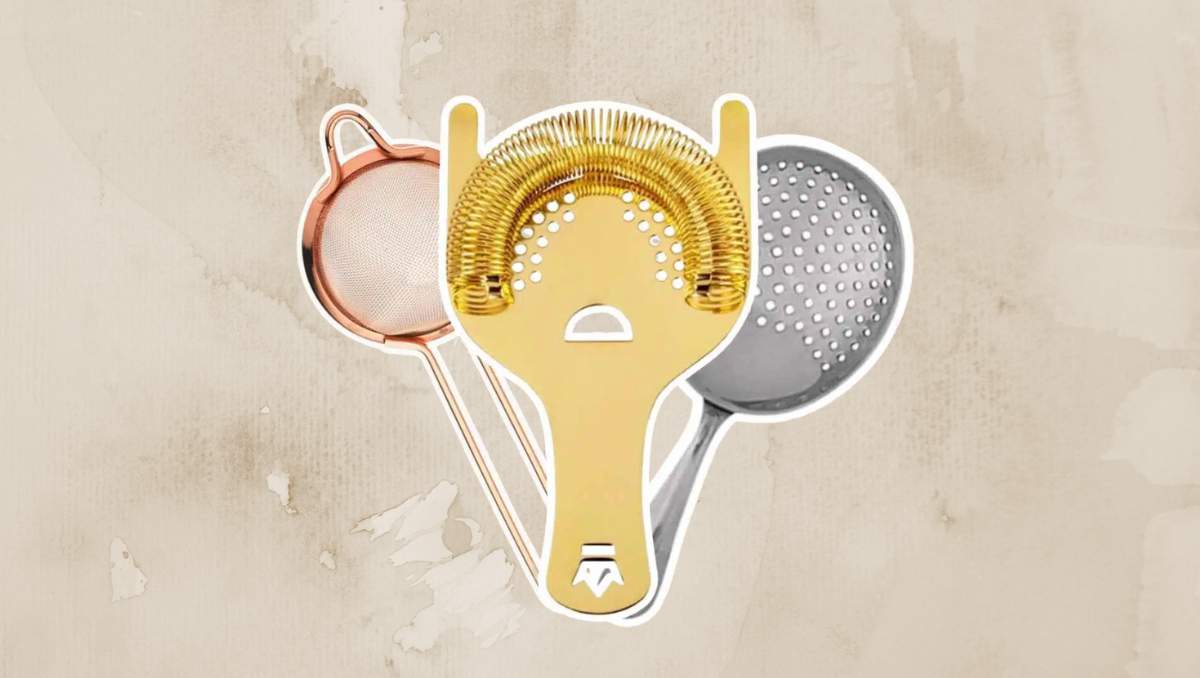A cocktail strainer is an essential bar tool that's indispensable for creating delicious quality cocktails. It keeps fruit pulp, kernels, ice used for mixing, and other residues out of your drink. Regardless if you stir your drink in a mixing glass or mix it using a cocktail shaker.
When you pour your cocktail, you want to filter out anything that's not supposed to be in your drink. So let me tell you all about cocktail strainers and how to use them.
What is a Cocktail Strainer? | Different Types | Hawthorne Strainer | Julep Strainer | Fine Mesh | Built-in | How to use it | Material | What to look for? | An alternative for home use
What is a Cocktail Strainer?
A cocktail strainer is an essential bartending tool. It's a sieve bartenders use to pour a perfect drink. The cocktail or bar strainer filters fruit pulp, ice shards, and other particles that shouldn't be part of your cocktail while it lets all the liquid pass into the glass.
Bartenders use it after shaking or stirring your drink. This step ensures that none of the mixing or shaking ice ends up in the final cocktail.
Cocktail strainers come in different types and shapes. We'll guide you through them and help you learn how to use them properly.
Different types of Bar or Cocktail Strainers
You've probably seen different strainers: the classic Hawthorne Strainer is the best-known, closely followed by the Julep Strainer. Those two types have specific purposes and advantages. Thus, usually, bartenders have both. Here's a short overview:
- 1. Hawthorne Strainer - It's the number one most-used bar sieve. This piece is super easy to use and revolutionized bartending. The flat metal tool comes with a spring to filter out ice and fruits and resembles traditional Chinese tea strainers.
- 2. Julep Strainer - The Julep is a more classic bar strainer that doesn't have a spring or coil.
- 3. Fine-mesh Strainer - This tool is an addition to another strainer. It helps filter out tiny bits of fruit or ice that might slip through the first straining tool.
- 4. Built-in Strainer - Some popular cocktail shakers have built-in strainers like the Cobbler.

The Hawthorne Strainer
The Hawthorne is the only cocktail-straining tool featuring a spring. This spring not only filters out ice and parts of fruits but also fits snugly on any mixing glass or shaker effortlessly. It easily adapts to different diameters and strains effectively.
Another thing you can do with this spring is to help make thick egg-white foam. Remove the spring and put it into your shaker when dry-shaking a cocktail with egg white or cream. That helps aerate the ingredients and makes them foamier.
Pros:
- Best fit for metal shaking tins
- Adjusts to different sizes
- Easy to use
Cons:
- Hard to clean
Recommendations: From Entry-level to Pro, here are my favorites, most of which I have at home, too:
- Hawthorne Strainer by cocktailor - This is a simple and inexpensive solution. This strainer is functional and is a good choice if you're starting your bartending career and don't want to spend a fortune on your bar tools.
- Sky Fish Hawthorne Strainer with 4 tabs - I like when the spring is rolled tightly as those coils will filter more ice and fruit bits.
- Modern Mixologist Hawthorne Strainer - Form usually follows function, but this piece combines both. It looks great in your home bar and is robust enough to stay with you for a long time.
Julep Strainer
A Julep is a traditional tool that is still used by bartenders regularly. Cocktail books from the mid-1800s show how cocktail enthusiasts strained cocktails into a second, empty glass.
This strainer is technically just a perforated piece of metal with a handle. Usually, it doesn't sit easily on top (or inside) of a shaker or mixing glass. Hence, it requires more practice to master straining cocktails with it.
The main advantage is its robustness. A good Julep Strainer is hard to ruin and can last forever. And even if it's a bit harder to handle, I recommend adding one to your collection of bar tools.
Pros:
- Very durable
- Easy to clean
Cons:
- Hard to use
- Not ideal for shaken cocktails (unless paired with a mesh strainer)
Recommendations: With Julep Strainers, you can't go wrong, really. Still, here is one I would recommend buying Piña Barware Julep Strainer. This piece has a unique design and offers good quality at a reasonable price.
Fine Mesh Strainer
A fine mesh is an addition, not a replacement for other stainers. Every time you read "double-strain", it's time to unpack your mesh strainer to get that cocktail right.
Other stainers will always let some small pieces of ice or fruit through that will end up in your cocktail. In most cases, this is not a problem. But there are some recipes where you need that velvety smoothness in your drink.
Pros:
- Filters tiny particles of fruit and ice
Cons:
- Hard to clean
Recommendations: Mesh strainers are usually quite affordable. There are many different versions, and not all are perfect for creating cocktails. Here are two different ones I can recommend without hesitation:
- Fine mesh cocktail strainer: This one is what I bought for home use. Would I get it again? Absolutely, as it is doing a great job and is very inexpensive.
- OXO fine mesh strainer: OXO tools are slightly more expensive than others. But you also get better quality as this strainer is very robust.
The built-in Strainer in Cobbler Shaker
Cobbler shakers have a built-in strainer. Even though it's convenient that it's a two-in-one solution and will keep out big pieces of ice, I don't recommend relying on that alone. Most of them allow too much residue to end up in your cocktail.
To prevent that, use a meshed strainer to keep the unwanted fruit and kernels out of your delicious cocktails.
Pros:
- Cheap as it's already included
Cons:
- Not straining that well (lets fruit pulp through)
- Clogs quickly
- Hard to clean
How to use a cocktail strainer
After shaking, you can put the Hawthorne Strainer on top of your shaker tin or mixing glass so that the metal tabs sit on the mixing vessel and the spring fits inside.
For a double strain, you hold a finely meshed strainer between the glass and the cocktail you strain through the Hawthorne Strainer.
A Julep Strainer is rarely used for a double strain. The standard use case is pouring stirred drinks from a mixing glass. To do that, you hold the bowl-shaped cup inside your mixing glass to prevent the ice from getting through.
The Julep Strainer will sit at an approximate 45-degree angle inside the mixing glass.
What are they made of?
You can get strainers in various qualities and materials. Most are stainless steel, then plated with copper, gold, and other colors. Usually, they are of 304 stainless steel.
If you want something more extraordinary and sophisticated, you also can get strainers made of massive copper, silver, or brass. While those pieces are more expensive, they're often handmade and develop a beautiful patina.
What to Look for When Buying a Bar Strainer?
When buying a bar strainer, you should choose a quality product that will help you prepare drinks. To find the perfect fit, you should pay attention to the following things.
- Material: Quality stainless steel is the best and most cost-effective option. Make sure that it's food-grade stainless steel.
- Coil: I prefer tightly rolled coils, not only because it looks better but also because a tight coil filters more fruit pulp and ice shards. As a rule of thumb: the tighter it's rolled, the better it will act as a filter.
- Ease of use: Not everyone is the same, some bartenders have bigger hands, others smaller ones. Make sure to choose a strainer that feels good and is easy for you to handle.
An alternative for home use
If you want to make cocktails at home and don't have the right tools, there are some alternatives to cocktail shakers and strainers you can use to improvise. A protein shaker, travel coffee mug, or plastic bottles are all great substitutes for a real shaker in case you don't have one. Glass jars can work too but tend to crack easily.
To strain your drink, you can use a lid and arrange it so that only the liquid can flow out of your shaker. Also, with a tea strainer or a fine-mesh kitchen strainer, you can also double-strain your drink

